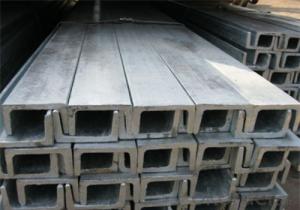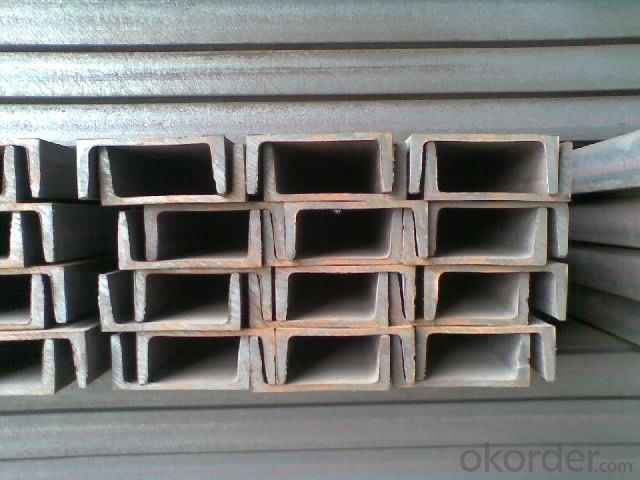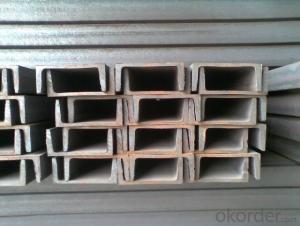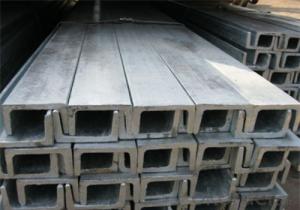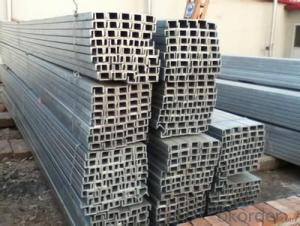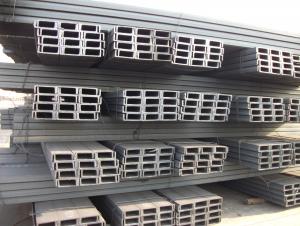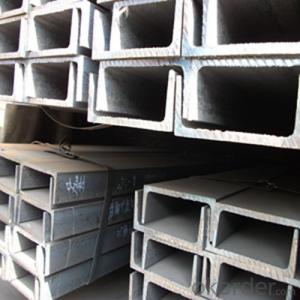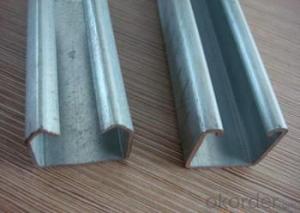U Channel Steel Mild Steel Size/Channel Steel Bar Sizes
- Loading Port:
- Tianjin
- Payment Terms:
- TT or LC
- Min Order Qty:
- 27 m.t.
- Supply Capability:
- 30000 m.t./month
OKorder Service Pledge
OKorder Financial Service
You Might Also Like
Product Description:
OKorder is offering U Channel Steel Mild Steel Size/Channel Steel Bar Sizes at great prices with worldwide shipping. Our supplier is a world-class manufacturer of steel, with our products utilized the world over. OKorder annually supplies products to European, North American and Asian markets. We provide quotations within 24 hours of receiving an inquiry and guarantee competitive prices.
Product Applications:
U Channel Steel Mild Steel Size/Channel Steel Bar Sizes are ideal for structural applications and are widely used in the construction of buildings and bridges, and the manufacturing, petrochemical, and transportation industries.
Product Advantages:
OKorder's U Channel Steel Mild Steel Size/Channel Steel Bar Sizes are durable, strong, and resist corrosion.
Main Product Features:
· Premium quality
· Prompt delivery & seaworthy packing (30 days after receiving deposit)
· Corrosion resistance
· Can be recycled and reused
· Mill test certification
· Professional Service
· Competitive pricing
Product Specifications:
Grade:Q195, Q215, Q235, Q345, SS400,S235JR,ST37-2 etc
Classification:Common channel and light channel
Channel according to the shape can be divided into four kinds: cold-formed channel equilateral, scalene cold-formed channel steel, cold-formed the curling channel steel, cold-formed outer edge channel
Model:5#-40#
Depth:50-400mm
Flange Width:37-104mm
Web Thickness:4.5-14.5mm
Weight:5.44-65.208kg/m
Length:6m, 9m, 12m or as your requirement
Business Model:Manufacturer and Exporter
production technology:
a)hot rolled u channel (ordinary channel & light channel)
b) cold-formed u channel
Surface Finish:
Painted
Pre-Galvanized
Hot Dipped Galvanized:
for outdoor use to BS EN 1461-1999, between 60 and 80 microns thick
Back to Back available
Electro zinc plated – for indoor use to BS EN 12329-2000
Note:hole channel can alsobe done as your request.
The hole size: 10*25 / 14*28 / 11*25 / 10.5*30 / 12*35mm
Application: Channel is mainly used for building structures, vehicle manufacturing, construction and other industries, such as fixed disk counters, channels and beam often used in conjunction.
FAQ:
Q1: Why buy Materials & Equipment from OKorder.com?
A1: All products offered byOKorder.com are carefully selected from China's most reliable manufacturing enterprises. Through its ISO certifications, OKorder.com adheres to the highest standards and a commitment to supply chain safety and customer satisfaction.
Q2: How do we guarantee the quality of our products?
A2: We have established an advanced quality management system which conducts strict quality tests at every step, from raw materials to the final product. At the same time, we provide extensive follow-up service assurances as required.
Q3: How soon can we receive the product after purchase?
A3: Within three days of placing an order, we will begin production. The specific shipping date is dependent upon international and government factors, but is typically 7 to 10 workdays.
Q4: What makes stainless steel stainless?
A4: Stainless steel must contain at least 10.5 % chromium. It is this element that reacts with the oxygen in the air to form a complex chrome-oxide surface layer that is invisible but strong enough to prevent further oxygen from "staining" (rusting) the surface. Higher levels of chromium and the addition of other alloying elements such as nickel and molybdenum enhance this surface layer and improve the corrosion resistance of the stainless material.
Q5: Can stainless steel rust?
A5: Stainless does not "rust" as you think of regular steel rusting with a red oxide on the surface that flakes off. If you see red rust it is probably due to some iron particles that have contaminated the surface of the stainless steel and it is these iron particles that are rusting. Look at the source of the rusting and see if you can remove it from the surface.
Images:
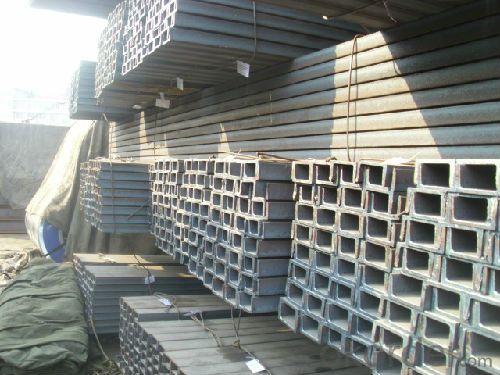
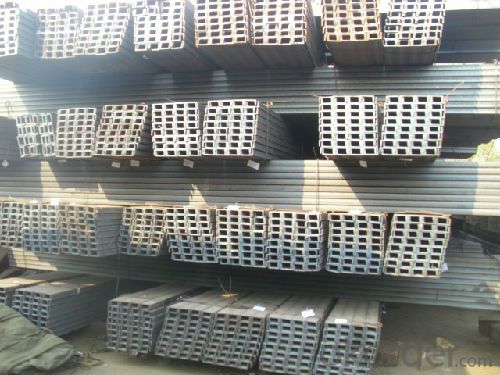
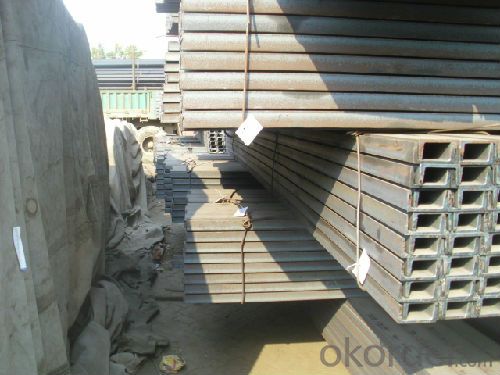
- Q: Can steel channels be used in airport terminal construction?
- Indeed, airport terminal construction does utilize steel channels. These channels, renowned for their robustness and resilience, are frequently employed in construction endeavors, including the creation of airport terminals. Their primary function is to offer structural support, serving as frames, reinforcements, and fulfilling diverse roles throughout the construction of these terminals. Steel channels are particularly favored in airport terminal construction due to their ability to withstand substantial burdens, rendering them apt for supporting sizable structures and guaranteeing the safety and stability of the terminal edifice. Moreover, steel channels can be effortlessly fabricated and installed, facilitating proficient construction procedures within airport terminal projects.
- Q: The telescopic arm is welded by channel steel and steel plate. Then the channel steel is inclined and the guide is not good enough. Is it a special profile? What are the telescopic arms?
- As for the welding standards, it is difficult to say, because this practice itself is a non-standard, it is difficult to have national standards, industry standards, and even enterprise standards
- Q: Such questions. Ask an expert to help advise!!
- I think it depends on the use of the attic. If it is out of the storage room, it is better to use channel steel. The construction is convenient, the cost is not high, and the bearing is enough. But if it is out of the room, it may be better to cast in placeMy home is a storage room, with the channel, did not shake the feeling, and the ceiling is not good. I want to crack crack is the ceiling decoration when do not cause, and with no direct relationship. What interlayer added: cast steel frame and each has its own advantages and disadvantages, in addition to the above several mentioned price factors, sound insulation effect, simple construction of the steel frame (relative cast-in-place for), as long as the proper construction (for experienced professional (staff) Company) should not be like the steel welding good will shake, 10000% ceiling cracking, the cost is not low, the cost is very high, the noise is too large for a long time. The wood board ceiling or rotten, cracking phenomenon, now generally spans more than 3 meters will be used to make steel, there are no shaking, and part of the ceiling steel frame does not occupy a space, can make a building Type, the cast is not good, if you want to do, you have to sacrifice height, and the general floor space is not very high, as the choice depends on your own intentions and needs
- Q: What are the factors to consider when selecting the right type of steel channel?
- To ensure the appropriate choice is made when selecting the right type of steel channel, several factors should be taken into consideration. These factors encompass: 1. Application type: Understanding the intended use of the steel channel is crucial. Different applications may necessitate different types of steel channels, including those used for structural support, framing, or decorative purposes. 2. Load capacity: Determining the expected load or weight that the steel channel will bear is of utmost importance. This information aids in selecting a channel with the appropriate strength and weight-bearing capacity. 3. Size and dimensions: The required size and dimensions of the steel channel should be considered. This entails the depth, width, and thickness, which should be chosen based on the specific project requirements, including the desired strength and stability. 4. Material grade: The material grade of the steel channel is vital as it determines the strength, durability, and corrosion resistance. Varied grades of steel, such as A36, A572, or A588, offer different levels of strength and suitability for diverse applications and environments. 5. Surface finish: The desired surface finish of the steel channel should be taken into account. This can range from a raw or mill finish, suitable for applications where appearance is not critical, to a galvanized or painted finish, which provides additional corrosion protection and enhances aesthetics. 6. Cost: The cost of the steel channel should be assessed in relation to the project budget. It is important to strike a balance between quality and cost-effectiveness, ensuring that the chosen steel channel meets the necessary requirements without exceeding the allocated budget. 7. Availability and lead time: The availability and lead time of the desired steel channel should be considered. This is particularly important for time-sensitive projects where quick delivery is crucial. By carefully considering these factors, one can make an informed decision when selecting the right type of steel channel. This ensures that it meets the specific project requirements and delivers optimal performance and durability.
- Q: What are the different types of reinforcements used with steel channels?
- Steel channels can be reinforced in several ways. One common method is by embedding them in concrete structures, which increases their strength and load-bearing capacity. Steel bars or rods can also be used to reinforce the channels, either within the channel itself or along its edges, to provide extra strength and rigidity. Brackets made of steel are another option for reinforcement, connecting and stabilizing multiple channels to prevent twisting or misalignment. Welding additional steel plates or sections to the channel is another effective method, particularly for situations with high forces or dynamic loads. Additionally, reinforced steel sections like I-beams can be attached to the channels to maximize strength and load-carrying capacity. Overall, these various reinforcements enhance the channels' stability and suitability for different construction and structural applications.
- Q: The parameters of the channel steel of Q235B
- Q235B is carbon structural steelIt consists of Q+ numeral + quality grade symbol + deoxidization method symbol. The steel dubbed "Q", representing the yield point of steel, behind the digital representation of the yield point value, in units of MPa such as Q235 (s) said the yield point for carbon steel 235 MPa. The necessary grades can be marked behind said deoxidation methods of quality grades and symbols. The quality class symbols are A, B, C, and D respectively. Deoxidation method notation: F means boiling steel; B represents semi killed steel: Z indicates calm steel; TZ stands for special sedation steel; calm steel is not marked; Z and TZ are not standard. For example, Q235-AF indicates a class of rimmed steel.
- Q: What are the advantages of using hot-rolled steel channels?
- Hot-rolled steel channels offer numerous benefits in various applications. To begin with, their structural integrity is exceptional. By heating the steel above its recrystallization temperature during the hot rolling process, a more uniform grain structure is achieved. As a result, the material becomes stronger and more durable, capable of withstanding heavy loads and high stress levels. Moreover, hot-rolled steel channels come in a wide range of sizes and shapes, making them versatile for different construction projects. With various dimensions available, including different heights, widths, and thicknesses, these channels offer flexibility in design and application. Furthermore, hot-rolled steel channels are cost-effective. The efficiency and relatively low cost of the hot rolling process make them more affordable compared to other structural materials. This makes them an attractive option for projects with limited budgets. In addition, hot-rolled steel channels exhibit excellent workability. The hot rolling process enhances the ductility of the steel, making it easier to shape, cut, and weld. This allows for efficient fabrication and customization of the channels to meet specific project requirements. Lastly, hot-rolled steel channels have a high degree of recyclability. Steel is one of the most recycled materials worldwide, and hot-rolled steel channels can be easily recycled and repurposed without compromising their structural properties. This environmentally friendly characteristic contributes to sustainable construction practices. In conclusion, the advantages of hot-rolled steel channels include superior structural integrity, versatility in size and shape, cost-effectiveness, good workability, and recyclability. These advantages make hot-rolled steel channels a popular choice in industries such as construction, manufacturing, and infrastructure development.
- Q: Can steel channels be used in high-temperature applications?
- Yes, steel channels can be used in high-temperature applications. Steel channels are known for their excellent resistance to high temperatures, making them suitable for various industrial applications such as furnaces, boilers, and heat exchangers. The high melting point and thermal stability of steel channels allow them to maintain their structural integrity and performance under high-temperature conditions.
- Q: How do steel channels contribute to the overall sustainability of a construction project?
- There are several ways in which steel channels contribute to the overall sustainability of a construction project. To begin with, they are manufactured using recycled materials, which reduces the demand for new resources and lessens the environmental impact of mining and processing raw materials. This helps conserve natural resources and reduces the energy needed for production, making steel channels a more sustainable choice. In addition, steel channels have a lengthy lifespan and require minimal maintenance. They are highly durable and resistant to corrosion, enabling them to withstand harsh weather conditions and endure for many years without needing replacement or frequent repairs. This reduces the overall use of materials and generation of waste, making the construction project more sustainable in the long term. Moreover, steel channels are lightweight and easy to transport. This decreases energy consumption and greenhouse gas emissions related to transportation, as less fuel is needed to move them from the manufacturing facility to the construction site. Furthermore, their lightweight nature makes them easier to handle and install, reducing the necessity for heavy machinery and the associated energy consumption during the construction process. Lastly, steel channels can be easily recycled at the end of their lifespan. Unlike other construction materials, steel can be melted down and reused multiple times without losing its properties. This not only reduces the amount of waste sent to landfills but also diminishes the need for new steel production, further conserving natural resources and decreasing environmental impact. To conclude, steel channels contribute to the overall sustainability of a construction project through their use of recycled materials, long lifespan, lightweight and easy transportability, and recyclability at the end of their life. By incorporating steel channels into construction projects, we can reduce environmental impact, conserve natural resources, and promote a more sustainable built environment.
- Q: What are the different types of steel channel sections?
- There are several different types of steel channel sections, including C channels, U channels, and Z channels. C channels have a C-shaped cross-section and are commonly used for structural applications such as framing and supports. U channels have a U-shaped cross-section and are often used as edging or trim on metal sheets or as structural components in construction. Z channels have a Z-shaped cross-section and are typically used for framing and support applications where additional strength is required.
Send your message to us
U Channel Steel Mild Steel Size/Channel Steel Bar Sizes
- Loading Port:
- Tianjin
- Payment Terms:
- TT or LC
- Min Order Qty:
- 27 m.t.
- Supply Capability:
- 30000 m.t./month
OKorder Service Pledge
OKorder Financial Service
Similar products
Hot products
Hot Searches
Related keywords
